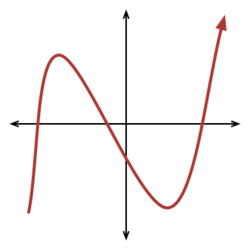Cubic's Real Roots
 The number of integers
n
for which
3
x
3
−
2
5
x
+
n
=
0
has three real roots is
The number of integers
n
for which
3
x
3
−
2
5
x
+
n
=
0
has three real roots is
This section requires Javascript.
You are seeing this because something didn't load right. We suggest you, (a) try
refreshing the page, (b) enabling javascript if it is disabled on your browser and,
finally, (c)
loading the
non-javascript version of this page
. We're sorry about the hassle.
2 solutions
Did you just mistook over there....and wrote > instead of < check once !!! By the way.....nice solution
Log in to reply
Yes, there's a typo in his solution. I was about to comment the same.
Specifically, it's the second inequality that has a typo. The final result is correct though.
Well, I didn't know this. I solved it with a somewhat similar method using calculus and graph plotting.
Analysis of the curve n = 2 5 x − 3 x 3 in the x − n plane shows that we have three real roots only at the points between the critical points (where the curve attains an extremum). Solving for critical points and finding value of n at those points gives us the bounds for the values of n that suffices the conditions of the given problem.
Applying Sturm's theorem to get the number of real roots of a polynomial, it is needed to compose a sequence, where the first polynomial comes from the statement, the second through the first derivative of the first polynomial and, with recurrence, the n-th polynomial is the remainder of the polynomial long division of a term by its sucessive term, multiplied by -1. These are the terms of Sturm sequence for the polynomial on the statement:
{ p 0 ( x ) = 3 x 3 − 2 5 x + n p 1 ( x ) = 9 x 2 − 2 5 p 2 ( x ) = 3 5 0 x − n p 3 ( x ) = 2 5 − 2 5 0 0 8 1 n 2 }
Evaluating each polynomial to the positive and negative infinities:
{ Negative infinity evaluating x → − ∞ lim p 0 ( x ) = x 3 ( 3 − x 2 2 5 + x 3 n ) = − ∞ x → − ∞ lim p 1 ( x ) = + ∞ x → − ∞ lim p 2 ( x ) = − ∞ x → − ∞ lim p 3 ( x ) → depends on n }
{ Positive infinity evaluating x → + ∞ lim p 0 ( x ) = + ∞ x → + ∞ lim p 1 ( x ) = + ∞ x → + ∞ lim p 2 ( x ) = + ∞ x → + ∞ lim p 3 ( x ) → depends on n }
For the case in which the fourth function on the Sturm sequence is positive, there'll be three changes of signal on evaluating the negative infinity, and none on evaluating the positive infinity. Thus, by Sturm's theorem, it must be three real roots for the fourth function as a positive value. Otherwise, if we set the fourth polynomial as negative, the number of changes of signal would imply in only one real root. When discussing the number of real roots by Sturm's theorem, the multiplicities are already discounted.
p 3 ( x ) > 0 → 2 5 > 2 5 0 0 8 1 n 2 → n 2 < 3 2 5 4 ⋅ 1 0 2 ± n < 3 2 5 0 → − 3 2 5 0 < n < 3 2 5 0
Since n must be an integer number, it lies on the interval below, which has the following number of terms:
S = # { n ∈ Z ∣ n ∈ [ − 2 7 , 2 7 ] } = 2 7 − ( − 2 7 ) + 1 = 55 integer possible values of n
A cubic equation has real roots if the y-value of the first extremum is the same sign as the leading coefficient and the y-value of the second extremum is the opposite sign as the leading coefficient.
The extrema: d x d y = 9 x 2 − 2 5 = 0 , x = − 3 5 is the local maximum (first extremum) and x = 3 5 is the local minimum (second extremum)
Therefore there are 5 5 possible integers n .